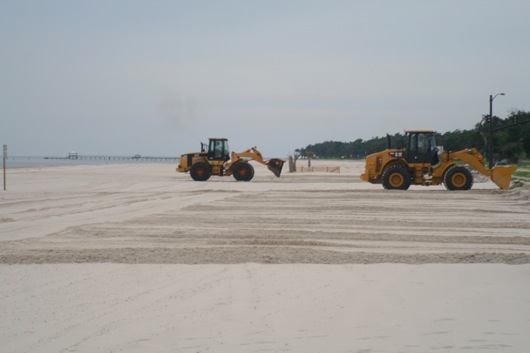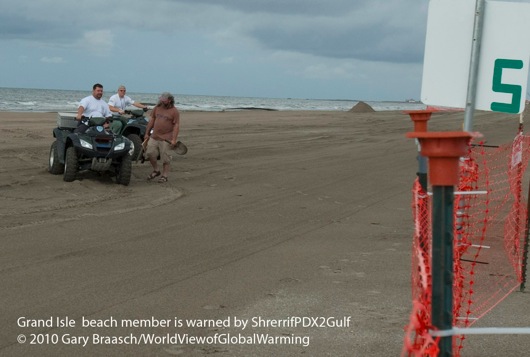An Absurd Experience on the Beach
One of the common themes that arises among locals in this region is whether BP is hiding things from the community. In fact the oil spill response area is run like a militarized zone with heavy handed security to make sure that the public only sees and hears what has been officially approved. Oil spill workers are very hesitant to talk–many will quickly tell you that you have to speak with the public Information Officer (PIO). Those that do talk are often furtive and tell you that they are not supposed to be talking with you… when you ask them for their names they quickly shake their heads no.
On Wednesday, team members Gary, Joan and I had a surreal experience that demonstrated just how absurd the secrecy can become…
We visited the beach at Grande Isle. It is a huge wide, sandy beach on one of the barrier islands that should be teaming with people on a hot, sunny summer day. Instead it looked like something out of Mad Max movie. A long orange plastic fence ran the length of the beach dividing the upper beach where the public is allowed to walk from the lower beach which is considered a “hot zone.” A giant “sand washing station” has been set up right on the beach to which a steady steam of dump trucks deliver and endless supply of sand to be cleaned. They are literally scraping the top layer of sand off of more than seven miles of beach and transporting it to this site where they tell us it will be made even cleaner than before the spill occurred.
The concept of “cleaner than before the spill” is intriguing and disturbing. Several members of our group heard this refrain at various times. Some workers alluded to the fact that this was not the first oil soil — in fact the sand is loaded with oil from decades of prior spills — BP is cleaning up the residue of other companies’ spills as well as their own as though that were a sign of some sort of beneficence. Beyond that one has to wonder about the concept of clean sand– sterilized would be a more apt description. It looks flat, burned and dead– you don’t usually notice the life in the sand, but seeing a “cleaned” beach makes you realized that the sand is alive with micro-organisms. The gulls and turns and shorebirds poke about in the sand up and down the beach– what are they finding? Would they consider this sand clean? Or is it simply adding another insult to the original injury of the oil spill?
The sand washing area would cover several football fields and is an amalgamation of trucks, tankers, heavy machinery, banks of flood lights on poles, tents, pipes, pools, platforms and fences. Warning signs are everywhere as are security and workers in hazmat suits. On the beach a steady parade of dump trucks, pick-up trucks, bulldozers and ORVs race up and down the sand. Zamboni-like sand scrapers move in convoys three trucks long scraping-up the sand. The beach is barren and unnatural– it looks like its top layer of skin has been torn off and it is covered in tracks from the vehicles and it reeks of the smell of oil. Out across the water in the distance, one can make out a virtual wall of oil platforms dotting the horizon.
It was on this desolate beach that Gary, Joan and I found ourselves observing one of the clean-up workers being reprimanded by his supervisor. He had dug a hole in the sand and discovered significant amounts of oil two feet below the surface. The discovery had triggered a great deal of commotion and several workers headed our way talking loudly. We were positioned by the “Decon Area,” the place where workers wash the oil off their boots and equipment in kiddy pools of citrus cleaner before exiting the hot zone. As the passed by, they told us “no pictures.” They seemed to forget about us as they stopped about 20 feet away and resumed their arguing. A truck pulled-up and more workers joined the group. A worker who stood nearby us muttered “somebody is going home.
The wind was blowing towards the workers and it was difficult to hear, but we could make out the worker who dug up the oil being loudly reprimanded. Suddenly they seemed to notice us again watching from 25 feet away. Things quieted down briefly and then a worker quickly walked towards us. He at first I though he was going to tell us to leave but instead he positioned himself just a few feet directly in front of us partially blocking our view of the other workers. At well over six feet tall and dressed in shiny yellow boots and a bright yellow t-shirt he would have been hard to ignore under normal circumstances, but instead of talking with us he immediately began jumping up and down flapping his arms and shrieking nonsensical sounds.
We asked him what he was doing and he paused his flapping long enough to say “distracting you.” Joan asked him why we were not being allowed to listen and he began to laugh. “I was sent over to distract you and that is what I am doing.” He then resumed his flapping and shrieking. We each took a step to the side and continued listening. For several minute we all held our respective positions– the BP supervisor tearing into the ditch digger, Joan, Gary and I watching and listening from 25 feet away, and this large man in neon yellow leaping about and making strange noises. Eventually the BP group broke-up, the reprimanded worker headed for the beach exits and the flapping ceased.
Grand Isle Beach from Uncage the Soul Productions on Vimeo.
By Bob Sallinger

























1 COMMENT
Hey y’all, your doing some fine posting here. Caught you an a retweet.
We hung this one on the Ladder, but had to link as well to the Individual Stories post.
Please keep it up!
Thank you.
Leave a comment